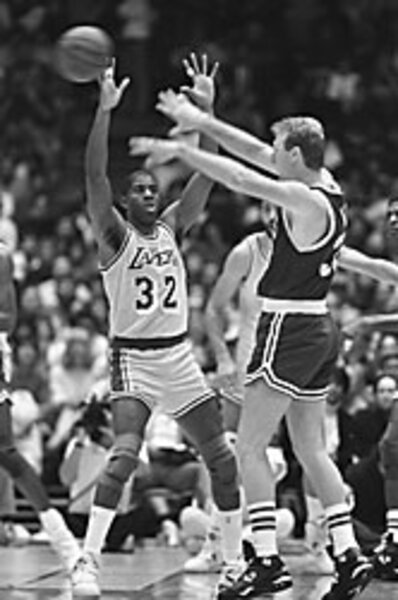Celtics vs. Lakers: Which laundry are you cheering for?
Loading...
| Accra, Ghana
On Thursday night, the Los Angeles Lakers and the Boston Celtics will resume the most famous rivalry in professional basketball. The two teams met in the NBA Finals seven times in the 1960s and three times in the 1980s, leaving an indelible mark on the game. So to American sports commentators and fans, who are sentimentalists at heart, this year's Final looks like a blast from the past.
Look again. Sports rivalries as we once knew them are dead, strangled by the constant movement of players between teams. These days, it seems, pro athletes change their uniforms more often than their underwear. That's why comedian Jerry Seinfeld has famously likened spectator sports to "cheering for the laundry."
This year in the NBA, there's plenty of new laundry to cheer for.
The Lakers were also-rans until January, when they acquired forward Pau Gasol from the Memphis Grizzlies. And the Celtics were absolutely woeful before the arrival of Kevin Garnett (from Minnesota) and Ray Allen (from Seattle). One Celtic reserve, Sam Cassell, is playing for his eighth NBA team; another, P.J. Brown, is on his sixth one.
Just before the trading deadline in February, in fact, more than 50 players changed squads in 11 different transactions. And one of those trades involved 11 different players! Quick, can you name the current employer of Ben Wallace, Larry Hughes, Drew Gooden, or Wally Szczerbiak? I didn't think so.
True, Lakers superstar and 2008 Most Valuable Player Kobe Bryant has been on the same team all along. Between 2000 and 2002, Bryant joined with Shaquille O'Neal to win three league titles. But then O'Neal departed for Miami, which traded him this season to the Phoenix Suns. The only other present-day Laker who played on the old championship teams is Derek Fisher, who made stops in the Golden State and Utah before coming back.
In the old days, players were much more likely to stay put. Bill Russell, the anchor of the great Celtics squads of the 1960s, spent his entire career with one team; so did Jerry West and Elgin Baylor, Russell's rivals on the Lakers. Ditto for the Celtics' Larry Bird and the Lakers' Magic Johnson, who did epic battle in the 1980s. They defined their teams, because Bird and Johnson never left them.
But there was always an unseemly side to the 1980s Lakers-Celtics rivalry, too, reflecting America's oldest and most bitter antagonism: the one between the races. Johnson was naturally athletic, fans said, and a showman to boot; Bird was efficient, no-nonsense, and hard-working.
Need I add that Johnson is black and Bird is white? In fact, neither player was an exceptionally gifted athlete: Johnson seemed flat-footed and lacked an outside jump shot, and Bird couldn't really jump at all. But according to a timeless stereotype, African-Americans are lazy; so if they succeed, we attribute it to innate ability. And when whites do well, we chalk it up to effort and willpower.
So the Celtics' other two white stars, Kevin McHale and Danny Ainge, were inevitably described as gritty, gutsy, or tenacious; by contrast, black Lakers such as James Worthy and Kareem Abdul-Jabbar were seen as innately quick, graceful, or strong. Leave aside the fact that Ainge was a good enough athlete to play professional baseball, as well, or that the 6 ft., 10 in. McHale was graced with an eight-foot wingspan. No, these were lunch-pail guys: they punched the clock, did the job, gave you 110 percent.
You know, like white people do.
None of this means that the Celtic players or organization were racist themselves. After all, we're talking about the first franchise to field five black starters under a white coach (Red Auerbach) and five white starters coached by an African-American (K.C. Jones). The prejudice lay not in the team, but in the way the rest of us perceived it: as somehow more deserving or honorable or even intelligent, because of its white players.
Next to this kind of rivalry, cheering for the laundry looks pretty good. Better to root for the color of a player's uniform than for – or against – the color of his skin.
So when the NBA teams reshuffle yet again, next year, I'll look back wistfully on a time when they stayed the same. But I'll also be glad that their racial makeup no longer matters. Hey, did you know that today's Lakers team has six white players, and the Celtics only have two? I bet you didn't. And it's a good thing, too.
• Jonathan Zimmerman, a professor of history and education at New York University, cheers for the laundry of the Philadelphia 76ers.





